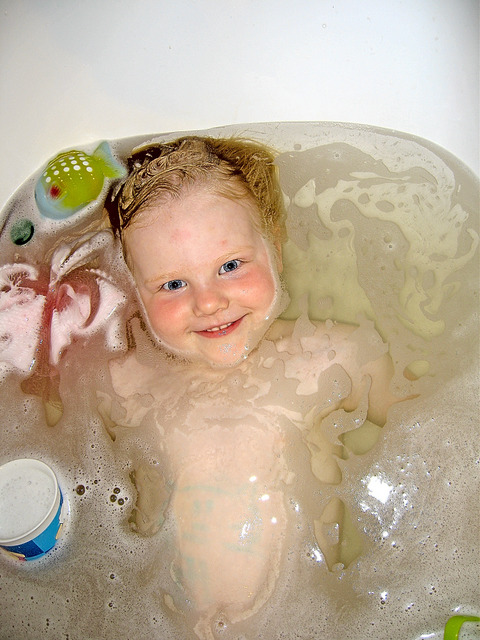Before I became the mother of a toddler, I remember listening to other parents describe their little one’s behavior with the term “terrible twos.”
To be honest, I had no idea what kind of behavior was meant by the term except that whatever was going on during this stage in a child’s development was somehow “terrible” or at the very least, challenging for the parents.
As my high need baby grows into an almost 2 year old, I am — and believe me, I am not bragging — now the enlightened mother of a child who is going through her terrible twos. My dear Annabelle is, one instant, a cheerful little girl who listens to mom and dad — and likes them — and the next, she is a take-charge, march-to-the-beat-of-her-own-drum rebel who has little patience for her pesky parents.
Since we practice Attachment Parenting, I often turn to other parents in my local API Support Group as well as books on Attachment Parenting. My favorites are those written by the Sears family; right now, The Discipline Book is helping me make sense of those intense “terrible twos” moments with my toddler, who the Sears might describe as a “tantrum-prone child.”
If you are a parent of a toddler who is short-tempered, you may be reading this post, nodding your head in understanding. If not, then consider yourself the lucky parent of a mellow toddler.
Whatever your experiences with your child, I hope you will understand that I love my daughter very much, am attentive to her, hold her, nurse her and do my very best to parent her from my heart. That said, there are times when I feel overwhelmed by her tantrums, and on those days when I am especially sleep-deprived and the world is foggy, I simply don’t know what to do…although I often consider these the best days to rest, lay low and let my little one read books in bed with me.
My own responses to my daughter’s tantrums range from giving in to her demands — for example, when she says “mine,” I passively tell her “okay” — to firmly saying “no,” which I really really dislike saying since it reminds me of own authoritarian father.
At a recent play date where Annabelle insisted on bringing her helium-inflated balloon, I foresaw the balloon triggering a tantrum or perhaps a power struggle with another child and then I observed the accuracy of my intuition when Annabelle pushed her playmate down as the child attempted to touch the balloon. In the past, I simply removed toys that triggered power struggles between children at our playgroups. This time, I apologized to the parent of the child who Annabelle pushed and then asked Annabelle to sign her apology to the child. I then told my daughter that the balloon needed to take a break. Perhaps because of the commotion, Annabelle completely melted down.
In The Discipline Book, the Sears devote an entire chapter to tantrums that they call “Taming Temper Tantrums.” Underlying the advice in this book is the Sears’ ideal that parents encourage “desirable actions” and discourage “undesirable behavior.” Below, I’ve listed several techniques that the Sears recommend for discouraging tantrums and other undesirable behaviors that I’ve found helpful:
- Practice Attachment Parenting — By practicing Attachment Parenting International’s Eight Principles of Parenting, we can establish a strong bond with our children and stay in tune with their emotions and thoughts.
- Identify triggers — As I mentioned earlier, I notice that certain situations will upset my daughter to the point that she feels like she is going to lose control, like sharing a favorite toy or leaving the park when she is having lots of fun. At the same time, I find myself surprised at times that she has become upset or needs some quiet time to herself. The Sears recommend making a behavior chart and noting what kinds of circumstances encourage desirable behavior versus undesirable behavior.
- Know yourself — A child who is prone to getting upset may have a parent who is also highly sensitive. By learning healthy ways to respond to a tantruming child, a sensitive parent may avoid making the situation worse by acting quickly. The Sears also suggest that parents who throw tantrums seek professional help so that they may move beyond their own undesirable behavior.
Even the most attentive of parents who are totally in tune with their children may find themselves with a tantrum-throwing child. Since our children are expressing their frustrations by throwing a tantrum, according to the Sears, parents can use these moments as opportunities to connect with their child. The Sears suggest that parents help give a word to what their children may be feeling while tantrumming, to gently hold and talk soothingly to the child, and to reassure the child that things will be okay.
With these approaches for managing tantrums, I feel more confident that I will be prepared to help my daughter the next time she gets upset and overwhelmed by her emotions.
What experiences have you had as the parent of a tantrum-prone toddler? What suggestions do you have for helping a child (and parents) manage overwhelming emotions? Have you found any books on Attachment Parenting to be helpful to you when your child was going through the “terrible” and “terrific” twos?


![Reblog this post [with Zemanta]](http://img.zemanta.com/reblog_e.png?x-id=d5fd631b-65b1-4312-8b34-fefaa458256a)













